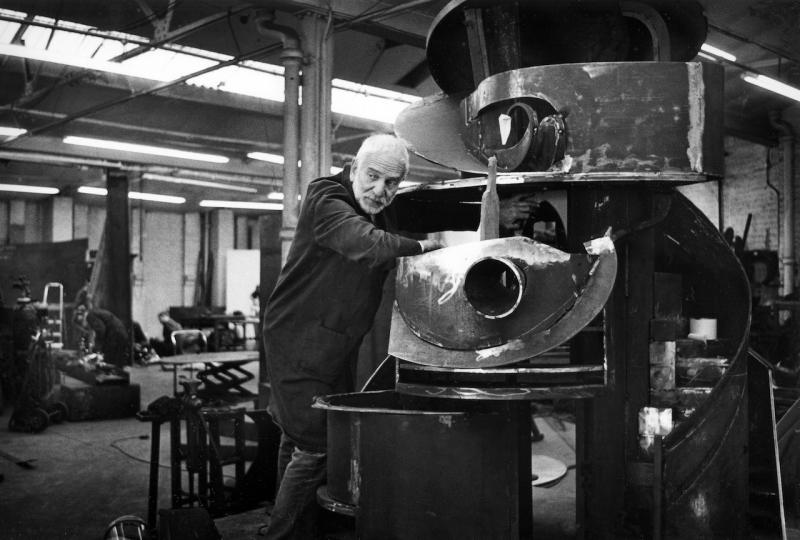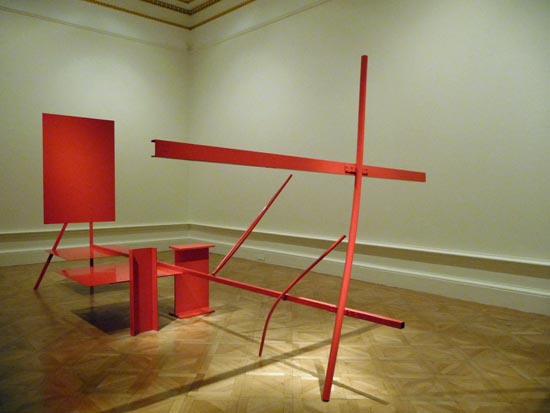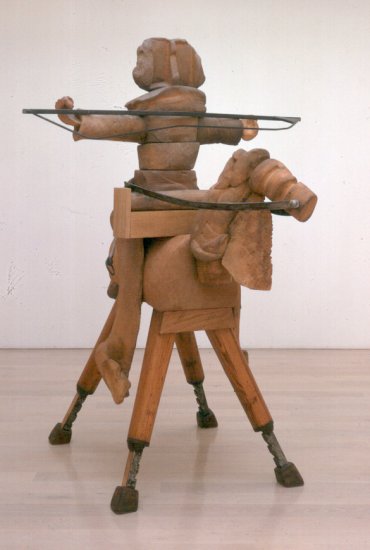Anthony Caro, 1924-2013 | reviews, news & interviews
Anthony Caro, 1924-2013
Anthony Caro, 1924-2013
The great British sculptor, who never let ego get in the way of the work, was inventive to the end

Sir Anthony Caro, who died on Wednesday of a heart attack aged 89, was an artist who remained not only active but inventive to the last.
Caro’s great innovations were the completely open form of his work, and the fact that it lay low and horizontal
In life, Caro cut a cheery, avuncular figure, and there was never any sense that the great esteem in which he was held as Britain’s greatest living sculptor after the death of Henry Moore, had led to an overweening ego. He must have been sensitive to that danger, since, as Moore’s assistant in the 1950s, he had seen it happen at close hand to his mentor: as Moore’s fame increased, and as the size of his sculpture followed suit, so, it appeared to Caro, did Moore’s ego.
Moore could never understand Caro’s radical departure from the figure. After visiting Caro’s solo exhibition at Whitechapel Gallery in 1963, he called the younger sculptor’s welded steel constructions “window dressing”. It was a cruel dismissal that Caro only learnt about decades later, after Moore had passed away. Caro’s interest was in the Cubism of intersecting planes, and his greatest influence from the late Fifties on was the work of David Smith, the great American sculptor associated with the Abstract Expressionists. It was Smith’s welded geometric forms in light-reflecting brushed steel that utterly seduced Caro on his first trip to the States.
 Caro is often cited as the first sculptor to do away with the plinth, but Smith had already gone in that direction with some of his Cubi, as had Brancusi before him. Caro’s great innovations were the completely open form of his work, the fact that it lay low and horizontal, at a level with the viewer, the fact that there was no frontal view (you could come at the work from any angle) and that it was painted, often in very bright colours. Early One Morning, 1962 (pictured above), is the seminal sculpture of the Sixties, and consists of a series of carefully balancing planes and lines in siren-red. Sculpture had never before appeared so light and airy, and with so much surrounding space.
Caro is often cited as the first sculptor to do away with the plinth, but Smith had already gone in that direction with some of his Cubi, as had Brancusi before him. Caro’s great innovations were the completely open form of his work, the fact that it lay low and horizontal, at a level with the viewer, the fact that there was no frontal view (you could come at the work from any angle) and that it was painted, often in very bright colours. Early One Morning, 1962 (pictured above), is the seminal sculpture of the Sixties, and consists of a series of carefully balancing planes and lines in siren-red. Sculpture had never before appeared so light and airy, and with so much surrounding space.
 In the Eighties, Caro surprised once again by returning to the figure, or at least introducing allusive and playfully figurative elements into his work. He borrowed heavily from art history and classical mythology, sometimes overtly. The Barbarians, 2000-2002, featured a group of six wild horsemen (pictured right: Golom) brandishing spears, bows and whips and accompanying a lonely figure on a chariot pulled by an ox; and one of his last great projects, and certainly among his most complex, was The Chapel of Light, 2008, at Saint-Jean Baptiste church in Bourbourg, Northern France.
In the Eighties, Caro surprised once again by returning to the figure, or at least introducing allusive and playfully figurative elements into his work. He borrowed heavily from art history and classical mythology, sometimes overtly. The Barbarians, 2000-2002, featured a group of six wild horsemen (pictured right: Golom) brandishing spears, bows and whips and accompanying a lonely figure on a chariot pulled by an ox; and one of his last great projects, and certainly among his most complex, was The Chapel of Light, 2008, at Saint-Jean Baptiste church in Bourbourg, Northern France.
A permanent architectural installation in the restored Gothic choir, which had been severely damaged during a bombing raid in the Second World War, The Chapel of Light consists of a rich variety of forms, from the severely geometric to those, rounded and voluptuous, alluding to the human figure. Here industrial steel, concrete, wood and stoneware are seamlessly combined in a rich palette of textures and natural colours.
Even at its apparently most solemn and most monumental, playfulness and humour are to be found everywhere in the work. Such mercurial qualities that the work possesses must surely have been part of the very fabric of Caro’s being.
Explore topics
Share this article
The future of Arts Journalism
You can stop theartsdesk.com closing!
We urgently need financing to survive. Our fundraising drive has thus far raised £49,000 but we need to reach £100,000 or we will be forced to close. Please contribute here: https://gofund.me/c3f6033d
And if you can forward this information to anyone who might assist, we’d be grateful.

Subscribe to theartsdesk.com
Thank you for continuing to read our work on theartsdesk.com. For unlimited access to every article in its entirety, including our archive of more than 15,000 pieces, we're asking for £5 per month or £40 per year. We feel it's a very good deal, and hope you do too.
To take a subscription now simply click here.
And if you're looking for that extra gift for a friend or family member, why not treat them to a theartsdesk.com gift subscription?
more Visual arts
 'We are bowled over!' Thank you for your messages of love and support
Much-appreciated words of commendation from readers and the cultural community
'We are bowled over!' Thank you for your messages of love and support
Much-appreciated words of commendation from readers and the cultural community
 Lee Miller, Tate Britain review - an extraordinary career that remains an enigma
Fashion photographer, artist or war reporter; will the real Lee Miller please step forward?
Lee Miller, Tate Britain review - an extraordinary career that remains an enigma
Fashion photographer, artist or war reporter; will the real Lee Miller please step forward?
 Kerry James Marshall: The Histories, Royal Academy review - a triumphant celebration of blackness
Room after room of glorious paintings
Kerry James Marshall: The Histories, Royal Academy review - a triumphant celebration of blackness
Room after room of glorious paintings
 Folkestone Triennial 2025 - landscape, seascape, art lovers' escape
Locally rooted festival brings home many but not all global concerns
Folkestone Triennial 2025 - landscape, seascape, art lovers' escape
Locally rooted festival brings home many but not all global concerns
 Sir Brian Clarke (1953-2025) - a personal tribute
Remembering an artist with a gift for the transcendent
Sir Brian Clarke (1953-2025) - a personal tribute
Remembering an artist with a gift for the transcendent
 Emily Kam Kngwarray, Tate Modern review - glimpses of another world
Pictures that are an affirmation of belonging
Emily Kam Kngwarray, Tate Modern review - glimpses of another world
Pictures that are an affirmation of belonging
 Kiefer / Van Gogh, Royal Academy review - a pairing of opposites
Small scale intensity meets large scale melodrama
Kiefer / Van Gogh, Royal Academy review - a pairing of opposites
Small scale intensity meets large scale melodrama
 Jenny Saville: The Anatomy of Painting, National Portrait Gallery review - a protégé losing her way
A brilliant painter in search of a worthwhile subject
Jenny Saville: The Anatomy of Painting, National Portrait Gallery review - a protégé losing her way
A brilliant painter in search of a worthwhile subject
 Abstract Erotic, Courtauld Gallery review - sculpture that is sensuous, funny and subversive
Testing the boundaries of good taste, and winning
Abstract Erotic, Courtauld Gallery review - sculpture that is sensuous, funny and subversive
Testing the boundaries of good taste, and winning
 Edward Burra, Tate Britain review - watercolour made mainstream
Social satire with a nasty bite
Edward Burra, Tate Britain review - watercolour made mainstream
Social satire with a nasty bite
 Ithell Colquhoun, Tate Britain review - revelations of a weird and wonderful world
Emanations from the unconscious
Ithell Colquhoun, Tate Britain review - revelations of a weird and wonderful world
Emanations from the unconscious
 Rachel Jones: Gated Canyons, Dulwich Picture Gallery review - teeth with a real bite
Mouths have never looked so good
Rachel Jones: Gated Canyons, Dulwich Picture Gallery review - teeth with a real bite
Mouths have never looked so good

Add comment